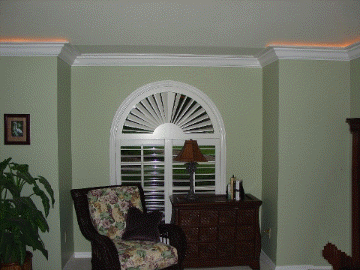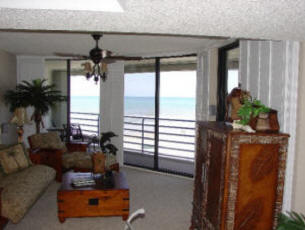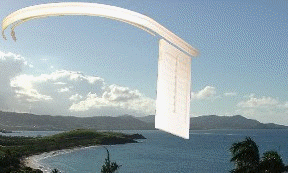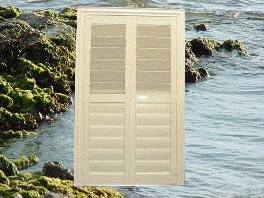|
Why
Shutters? |
•
Looks
• Light Control
• Insulation
• Life Expectancy |
Shutters deliver the "goods." GREAT looks, GREAT light
control, GREAT insulation and GREAT life expectancy.
The most important value of Plantation shutters is their extreme durability.
Draperies, curtains and blinds will succumb to normal wear and tear. Thermalite remain in their original high quality state for
years to come. Light control can vary from opening the
plantation shutters away
from the window for a full view, to closing all plantation shutters and louvers
for an almost black-out effect.
|
|
Shutters have been used as an adjustable
window covering for centuries. The look is clean and the design is
functional. Opened louvers allow high light penetration. Adjusting the
louvers varies the light penetration down to full closure. Shutters
provide a finished look . |
Considering Shutters for your home? Let me help educate you on the
benefits of Thermalite Shutters. Thermalite is made of an extruded
foam. Thermalite is a 100 percent non toxic solid material designed
to be unaffected by the weather.
Shutters can be used indoors as well as outdoors. Plantation
shutters can be installed on a lanai or used around a pool for
privacy.
Thermalite Shutters were designed for the most particular wood
shutter customer. They truly look and feel just like wood. Even
people in the industry have a hard time telling the difference.
Thermalite Shutters have an exclusive reinforced louver. This
reinforced louver will allow you to go up to a thirty-eight inch
panel.
We also offer Ultra Clear shutters. Ultra Clear plantation
shutters have eliminated the tilt bar altogether. Ultra Clear
plantation shutters have an invisible internal mechanism that allows
you to adjust all of your louvers by simply touching one.
Ultra Clear shutters can be divided into as many different sections
as you would like. Perhaps just two sections to allow the bottom to
be closed for privacy and the top left open for light, perhaps more.
Really, the possibilities are endless.
|

Sliding wood window shutters in Florida house |

French doors window shutters in Lake Mary house, Fl

|
|
Sliding plantation window shutters in Sarasota house, Fl
 |
|
Sliding plantation window shutters in Daytona Beach condo, Fl |

Sliding wood window shutters in Florida house |

Bath room window shutters in Lake Mary house, Fl |

Plantation window shutters in Orlando house, Fl |

Specialty window plantation shutters in Orlando house, Fl |

Arch window plantation shutters in Tampa house, Fl |

Window shutters in Sarasota house, Fl |

Specialty shapes window shutters in Orlando house, Fl |
Early Human Habitation
People first reached Florida at least 12,000 years ago.
The rich variety of environments in prehistoric Florida
supported a large number of plants and animals. The
animal population included most mammals that we know
today. In addition, many other large mammals that are
now extinct (such as the saber-tooth tiger, mastodon,
giant armadillo, and camel) roamed the land.
The Florida coastline along the Atlantic Ocean and the
Gulf of Mexico was very different 12,000 years ago. The
sea level was much lower than it is today. As a result,
the Florida peninsula was more than twice as large as it
is now. The people who inhabited Florida at that time
were hunters and gatherers, who only rarely sought big
game for food. Modern researchers think that their diet
consisted of small animals, plants, nuts, and shellfish.
These first Floridians settled in areas where a steady
water supply, good stone resources for tool making, and
firewood were available. Over the centuries, these
native people developed complex cultures. During the
period prior to contact with Europeans, native societies
of the peninsula developed cultivated agriculture,
traded with other groups in what is now the southeastern
United States, and increased their social organization,
reflected in large temple mounds and village complexes.
European Exploration and Colonization
Written records about life in Florida began with the
arrival of the Spanish explorer and adventurer Juan
Ponce de León in 1513. Sometime between April 2 and
April 8, Ponce de León waded ashore on the northeast
coast of Florida, possibly near present-day St.
Augustine. He called the area la Florida, in honor of
Pascua florida ("feast of the flowers"), Spain’s
Eastertime celebration. Other Europeans may have reached
Florida earlier, but no firm evidence of such
achievement has been found.
On another voyage in 1521, Ponce de León landed on the
southwestern coast of the peninsula, accompanied by
two-hundred people, fifty horses, and numerous beasts of
burden. His colonization attempt quickly failed because
of attacks by native people. However, Ponce de León’s
activities served to identify Florida as a desirable
place for explorers, missionaries, and treasure seekers.
In 1539 Hernando de Soto began another expedition in
search of gold and silver, which took him on a long trek
through Florida and what is now the southeastern United
States. For four years, de Soto’s expedition wandered,
in hopes of finding the fabled wealth of the Indian
people. De Soto and his soldiers camped for five months
in the area now known as Tallahassee. De Soto died near
the Mississippi River in 1542. Survivors of his
expedition eventually reached Mexico.
No great treasure troves awaited the Spanish
conquistadores who explored Florida. However, their
stories helped inform Europeans about Florida and its
relationship to Cuba, Mexico, and Central and South
America, from which Spain regularly shipped gold,
silver, and other products. Groups of heavily-laden
Spanish vessels, called plate fleets, usually sailed up
the Gulf Stream through the straits that parallel
Florida’s Keys. Aware of this route, pirates preyed on
the fleets. Hurricanes created additional hazards,
sometimes wrecking the ships on the reefs and shoals
along Florida’s eastern coast.
In 1559 Tristán de Luna y Arellano led another attempt
by Europeans to colonize Florida. He established a
settlement at Pensacola Bay, but a series of misfortunes
caused his efforts to be abandoned after two years.
Spain was not the only European nation that found
Florida attractive. In 1562 the French protestant Jean
Ribault explored the area. Two years later, fellow
Frenchman René Goulaine de Laudonnière established Fort
Caroline at the mouth of the St. Johns River, near
present-day Jacksonville.
First Spanish Period
These French adventurers prompted Spain to accelerate
her plans for colonization. Pedro Menéndez de Avilés
hastened across the Atlantic, his sights set on removing
the French and creating a Spanish settlement. Menéndez
arrived in 1565 at a place he called San Augustín (St.
Augustine) and established the first permanent European
settlement in what is now the United States. He
accomplished his goal of expelling the French, attacking
and killing all settlers except for non-combatants and
Frenchmen who professed belief in the Roman Catholic
faith. Menéndez captured Fort Caroline and renamed it
San Mateo.
French response came two years later, when Dominique de
Gourgues recaptured San Mateo and made the Spanish
soldiers stationed there pay with their lives. However,
this incident did not halt the Spanish advance. Their
pattern of constructing forts and Roman Catholic
missions continued. Spanish missions established among
native people soon extended across north Florida and as
far north along the Atlantic coast as the area that we
now call South Carolina.
The English, also eager to exploit the wealth of the
Americas, increasingly came into conflict with Spain’s
expanding empire. In 1586 the English captain Sir
Francis Drake looted and burned the tiny village of St.
Augustine. However, Spanish control of Florida was not
diminished.
In fact, as late as 1600, Spain’s power over what is now
the southeastern United States was unquestioned. When
English settlers came to America, they established their
first colonies well to the North—at Jamestown (in the
present state of Virginia) in 1607 and Plymouth (in the
present state of Massachusetts) in 1620. English
colonists wanted to take advantage of the continent’s
natural resources and gradually pushed the borders of
Spanish power southward into present-day southern
Georgia. At the same time, French explorers were moving
down the Mississippi River valley and eastward along the
Gulf Coast.
The English colonists in the Carolina colonies were
particularly hostile toward Spain. Led by Colonel James
Moore, the Carolinians and their Creek Indian allies
attacked Spanish Florida in 1702 and destroyed the town
of St. Augustine. However, they could not capture the
fort, named Castillo de San Marcos. Two years later,
they destroyed the Spanish missions between Tallahassee
and St. Augustine, killing many native people and
enslaving many others. The French continued to harass
Spanish Florida’s western border and captured Pensacola
in 1719, twenty-one years after the town had been
established.
Spain’s adversaries moved even closer when England
founded Georgia in 1733, its southernmost continental
colony. Georgians attacked Florida in 1740, assaulting
the Castillo de San Marcos at St. Augustine for almost a
month. While the attack was not successful, it did point
out the growing weakness of Spanish Florida.
British Florida
Britain gained control of Florida in 1763 in exchange
for Havana, Cuba, which the British had captured from
Spain during the Seven Years’ War (1756–63). Spain
evacuated Florida after the exchange, leaving the
province virtually empty. At that time, St. Augustine
was still a garrison community with fewer than five
hundred houses, and Pensacola also was a small military
town.
The British had ambitious plans for Florida. First, it
was split into two parts: East Florida, with its capital
at St. Augustine; and West Florida, with its seat at
Pensacola. British surveyors mapped much of the
landscape and coastline and tried to develop relations
with a group of Indian people who were moving into the
area from the North. The British called these people of
Creek Indian descent Seminolies, or Seminoles. Britain
attempted to attract white settlers by offering land on
which to settle and help for those who produced products
for export. Given enough time, this plan might have
converted Florida into a flourishing colony, but British
rule lasted only twenty years.
The two Floridas remained loyal to Great Britain
throughout the War for American Independence (1776–83).
However, Spain—participating indirectly in the war as an
ally of France—captured Pensacola from the British in
1781. In 1784 it regained control of the rest of Florida
as part of the peace treaty that ended the American
Revolution.
Second Spanish Period
When the British evacuated Florida, Spanish colonists as
well as settlers from the newly formed United States
came pouring in. Many of the new residents were lured by
favorable Spanish terms for acquiring property, called
land grants. Others who came were escaped slaves, trying
to reach a place where their U.S. masters had no
authority and effectively could not reach them. Instead
of becoming more Spanish, the two Floridas increasingly
became more "American." Finally, after several official
and unofficial U.S. military expeditions into the
territory, Spain formally ceded Florida to the United
States in 1821, according to terms of the Adams-Onís
Treaty.
On one of those military operations, in 1818, General
Andrew Jackson made a foray into Florida. Jackson’s
battles with Florida’s Indian people later would be
called the First Seminole War.
Territorial Period
Andrew Jackson returned to Florida in 1821 to establish
a new territorial government on behalf of the United
States. What the U.S. inherited was a wilderness
sparsely dotted with settlements of native Indian
people, African Americans, and Spaniards.
As a territory of the United States, Florida was
particularly attractive to people from the older
Southern plantation areas of Virginia, the Carolinas,
and Georgia, who arrived in considerable numbers. After
territorial status was granted, the two Floridas were
merged into one entity with a new capital city in
Tallahassee. Established in 1824, Tallahassee was chosen
because it was halfway between the existing governmental
centers of St. Augustine and Pensacola.
As Florida’s population increased through immigration,
so did pressure on the federal government to remove the
Indian people from their lands. The Indian population
was made up of several groups—primarily, the Creek and
the Miccosukee people; and many African American
refugees lived with the Indians. Indian removal was
popular with white settlers because the native people
occupied lands that white people wanted and because
their communities often provided a sanctuary for runaway
slaves from northern states.
Among Florida’s native population, the name of Osceola
has remained familiar after more than a century and a
half. Osceola was a Seminole war leader who refused to
leave his homeland in Florida. Seminoles, already noted
for their fighting abilities, won the respect of U.S.
soldiers for their bravery, fortitude, and ability to
adapt to changing circumstances during the Second
Seminole War (1835–42). This war, the most significant
of the three conflicts between Indian people and U.S.
troops in Florida, began over the question of whether
Seminoles should be moved westward across the
Mississippi River into what is now Oklahoma.
Under President Andrew Jackson, the U.S. government
spent $20 million and the lives of many U.S. soldiers,
Indian people, and U.S. citizens to force the removal of
the Seminoles. In the end, the outcome was not as the
federal government had planned. Some Indians migrated
"voluntarily." Some were captured and sent west under
military guard; and others escaped into the Everglades,
where they made a life for themselves away from contact
with whites.
Today, reservations occupied by Florida’s Indian people
exist at Immokalee, Hollywood, Brighton (near the city
of Okeechobee), and along the Big Cypress Swamp. In
addition to the Seminole people, Florida also has a
separate Miccosukee tribe.
By 1840 white Floridians were concentrating on
developing the territory and gaining statehood. The
population had reached 54,477 people, with African
American slaves making up almost one-half of the
population. Steamboat navigation was well established on
the Apalachicola and St. Johns Rivers, and railroads
were planned.
Florida now was divided informally into three areas:
East Florida, from the Atlantic Ocean to the Suwannee
River; Middle Florida, between the Suwannee and the
Apalachicola Rivers; and West Florida, from the
Apalachicola to the Perdido River. The southern area of
the territory (south of present-day Gainesville) was
sparsely settled by whites. The territory’s economy was
based on agriculture. Plantations were concentrated in
Middle Florida, and their owners established the
political tone for all of Florida until after the Civil
War.
Statehood
Florida became the twenty-seventh state in the United
States on March 3, 1845. William D. Moseley was elected
the new state’s first governor, and David Levy Yulee,
one of Florida’s leading proponents for statehood,
became a U.S. Senator. By 1850 the population had grown
to 87,445, including about 39,000 African American
slaves and 1,000 free blacks.
The slavery issue began to dominate the affairs of the
new state. Most Florida voters—who were white males,
ages twenty-one years or older—did not oppose slavery.
However, they were concerned about the growing feeling
against it in the North, and during the 1850s they
viewed the new anti-slavery Republican party with
suspicion. In the 1860 presidential election, no
Floridians voted for Abraham Lincoln, although this
Illinois Republican won at the national level. Shortly
after his election, a special convention drew up an
ordinance that allowed Florida to secede from the Union
on January 10, 1861. Within several weeks, Florida
joined other southern states to form the Confederate
States of America.
Civil War and Reconstruction
During the Civil War, Florida was not ravaged as several
other southern states were. Indeed, no decisive battles
were fought on Florida soil. While Union forces occupied
many coastal towns and forts, the interior of the state
remained in Confederate hands.
Florida provided an estimated 15,000 troops and
significant amounts of supplies— including salt, beef,
pork, and cotton—to the Confederacy, but more than 2,000
Floridians, both African American and white, joined the
Union army. Confederate and foreign merchant ships
slipped through the Union navy blockade along the coast,
bringing in needed supplies from overseas ports.
Tallahassee was the only southern capital east of the
Mississippi River to avoid capture during the war,
spared by southern victories at Olustee (1864) and
Natural Bridge (1865). Ultimately, the South was
defeated, and federal troops occupied Tallahassee on May
10, 1865.
Before the Civil War, Florida had been well on its way
to becoming another of the southern cotton states.
Afterward, the lives of many residents changed. The
ports of Jacksonville and Pensacola again flourished due
to the demand for lumber and forest products to rebuild
the nation’s cities. Those who had been slaves were
declared free. Plantation owners tried to regain prewar
levels of production by hiring former slaves to raise
and pick cotton. However, such programs did not work
well, and much of the land came under cultivation by
tenant farmers and sharecroppers, both African American
and white.
Beginning in 1868, the federal government instituted a
congressional program of "reconstruction" in Florida and
the other southern states. During this period,
Republican officeholders tried to enact sweeping
changes, many of which were aimed at improving
conditions for African Americans.
At the time of the 1876 presidential election, federal
troops still occupied Florida. The state’s Republican
government and recently enfranchised African American
voters helped to put Rutherford B. Hayes in the White
House. However, Democrats gained control of enough state
offices to end the years of Republican rule and prompt
the removal of federal troops the following year. A
series of political battles in the state left African
Americans with little voice in their government.
Florida Development
During the final quarter of the nineteenth century,
large-scale commercial agriculture in Florida,
especially cattle-raising, grew in importance.
Industries such as cigar manufacturing took root in the
immigrant communities of the state.
Potential investors became interested in enterprises
that extracted resources from the water and land. These
extractive operations were as widely diverse as sponge
harvesting in Tarpon Springs and phosphate mining in the
southwestern part of the state. The Florida citrus
industry grew rapidly, despite occasional freezes and
economic setbacks. The development of industries
throughout the state prompted the construction of roads
and railroads on a large scale.
Beginning in the 1870s, residents from northern states
visited Florida as tourists to enjoy the state’s natural
beauty and mild climate. Steamboat tours on Florida’s
winding rivers were a popular attraction for these
visitors.
The growth of Florida’s transportation industry had its
origins in 1855, when the state legislature passed the
Internal Improvement Act. Like legislation passed by
several other states and the federal government,
Florida’s act offered cheap or free public land to
investors, particularly those interested in
transportation. The act, and other legislation like it,
had its greatest effect in the years between the end of
the Civil War and the beginning of World War I. During
this period, many railroads were constructed throughout
the state by companies owned by Henry Flagler and Henry
B. Plant, who also built lavish hotels near their
railroad lines. The Internal Improvement Act stimulated
the initial efforts to drain the southern portion of the
state in order to convert it to farmland.
These development projects had far-reaching effects on
the agricultural, manufacturing, and extractive
industries of late-nineteenth-century Florida. The
citrus industry especially benefitted, since it was now
possible to pick oranges in south Florida; put them on a
train heading north; and eat them in Baltimore,
Philadelphia, or New York in less than a week.
In 1898 national attention focused on Florida, as the
Spanish-American War began. The port city of Tampa
served as the primary staging area for U.S. troops bound
for the war in Cuba. Many Floridians supported the Cuban
peoples’ desire to be free of Spanish colonial rule.
By the turn of the century, Florida’s population and per
capita wealth were increasing rapidly; the potential of
the "Sunshine State" appeared endless. By the end of
World War I, land developers had descended on this
virtual gold mine. With more Americans owning
automobiles, it became commonplace to vacation in
Florida. Many visitors stayed on, and exotic projects
sprang up in southern Florida. Some people moved onto
land made from drained swamps. Others bought
canal-crossed tracts through what had been dry land. The
real estate developments quickly attracted buyers, and
land in Florida was sold and resold. Profits and prices
for many developers reached inflated levels.
The Great Depression in Florida
Florida’s economic bubble burst in 1926, when money and
credit ran out, and banks and investors abruptly stopped
trusting the "paper" millionaires. Severe hurricanes
swept through the state in the 1926 and 1928, further
damaging Florida’s economy.
By the time the Great Depression began in the rest of
the nation in 1929, Floridians had already become
accustomed to economic hardship.
In 1929 the Mediterranean fruit fly invaded the state,
and the citrus industry suffered. A quarantine was
established, and troops set up roadblocks and
checkpoints to search vehicles for any contraband citrus
fruit. Florida’s citrus production was cut by about
sixty percent.
State government began to represent a larger proportion
of its citizens. Female citizens won the right to vote
in 1920, when the Nineteenth Amendment to the U.S.
Constitution became law. In 1937, the requirement that
voters pay a "poll tax" was repealed, allowing poor
African American and white Floridians to have a greater
voice in government. In 1944 the U.S. Supreme Court
outlawed a system of all-white primary elections that
had limited the right of African Americans to vote.
World War II and the Post-war "Boom"
World War II spurred economic development in Florida.
Because of its year-round mild climate, the state became
a major training center for soldiers, sailors, and
aviators of the United States and its allies. Highway
and airport construction accelerated so that, by war’s
end, Florida had an up-to-date transportation network
ready for use by residents and the visitors who seemed
to arrive in an endless stream.
One of the most significant trends of the postwar era
has been steady population growth, resulting from large
migrations to the state from within the U.S. and from
countries throughout the western hemisphere, notably
Cuba and Haiti. Florida is now the fourth most populous
state in the nation.
The people who make up Florida’s diverse population have
worked to make the Sunshine State a place where all
citizens have equal rights under the law. Since the
1950s, Florida’s public education system and public
places have undergone great changes. African American
citizens, joined by Governor LeRoy Collins and other
white supporters, fought to end racial discrimination in
schools and other institutions.
Since World War II, Florida’s economy also has become
more diverse. Tourism, cattle, citrus, and phosphate
have been joined by a host of new industries that have
greatly expanded the numbers of jobs available to
residents. Electronics, plastics, construction, real
estate, and international banking are among the state’s
more recently-developed industries.
Several major U.S. corporations have moved their
headquarters to Florida. An interstate highway system
exists throughout the state, and Florida is home to
major international airports. The university and
community college system has expanded rapidly, and
high-technology industries have grown steadily. The U.S.
space program—with its historic launches from Cape
Canaveral, lunar landings, and the development of the
space shuttle program—has brought much media attention
to the state. The citrus industry continues to prosper,
despite occasional winter freezes, and tourism also
remains important, bolstered by large capital
investments. Florida attractions, such as the large
theme parks in the Orlando area, bring millions of
visitors to the state from across the U.S. and around
the world
Today, Floridians study their state’s long history to
learn more about the lives of the men and women who
shaped their exciting past. By learning about our rich
and varied heritage, we can draw lessons to help create
a better Florida for all of its citizens.
|
|
|
| Specialty Shapes |
|
Did you know that we can custom
make shutters for almost any shape window? Arches, circular windows
and triangles are no problem!
Our sliding shutters can be made any
shape and any size!
Now
we are featuring...
ULTRA CLEAR
Shutters for the twenty-first century...
We have taken SHUTTERS to an
entirely different level!
State of the art !
Shutters designed for those who do not wish to
have their view obstructed!
One touch controls!
Adjust shutters by simply touching one louver!
BE PREPARED TO BE IMPRESSED!!
|
|
One company does it
all...Design, Measure, Manufacture &Install!!!
Shutters are an
investment in your home. As with any investment, be sure and and
do the research.
Florida Blinds and Shutters have been unsurpassed in quality !
Providing you, the consumer, with superior products that can
stand the test of time.
Florida Blinds and
Shutters use on grade A, furniture quality Bass and Poplar wood
in our exclusive wood line.
CHECK OUT OUR EXCLUSIVE FAUX
FINISHES for a truly one of a kind look!
|
Maybe you love stained glass. We can insert
stained glass into your shutter. Providing a
beautiful display of art in your home.

Specialty window shutters in Orlando house, Fl
Shutters truly are the one piece that can
turn you house into a home.
Shutters will be there as long as your home
is there.
Shutters can transform themselves from very
traditional to very contemporary.
Plantation shutters will be the one thing in
your home that can change with the times.
SHUTTERS ARE SIMPLY TIMELESS!!!
|
|

Plantation window
shutters
in Windermere house,
Fl
|

French doors window shutters in Lake Mary house, Fl

Specialty shapes window shutters in Orlando house, Fl

Arc window shutters in Tampa area house, Fl |

Specialty shapes window shutters in Longwood house, Fl |
 Specialty
shapes window plantation shutters in Windermere house, Fl Specialty
shapes window plantation shutters in Windermere house, Fl |

Plantation window shutters in Winter Park house, Fl |

Plantation window shutters in Tampa house, Fl

Plantation shutters in Winter Park house, Fl

Plantation window shutters in Windermere house, Fl
|
|
|
|
 |









.htm_cmp_expeditn110_vbtn.gif)




























 Specialty
shapes window plantation shutters in Windermere house, Fl
Specialty
shapes window plantation shutters in Windermere house, Fl















